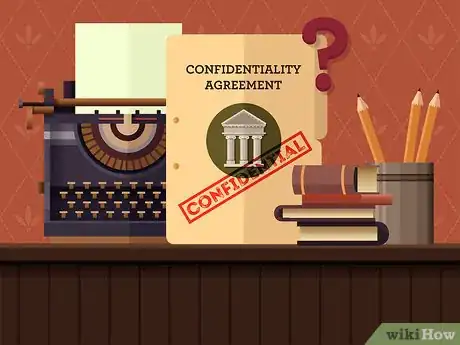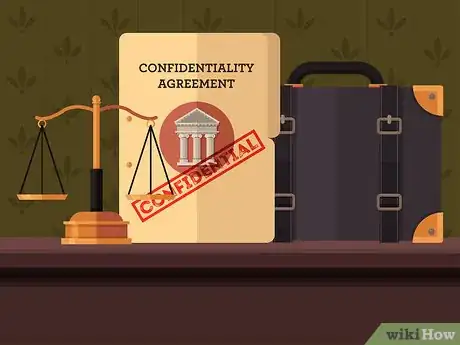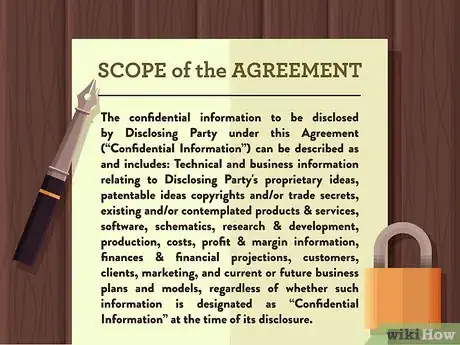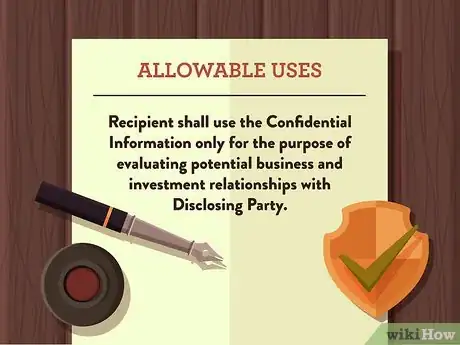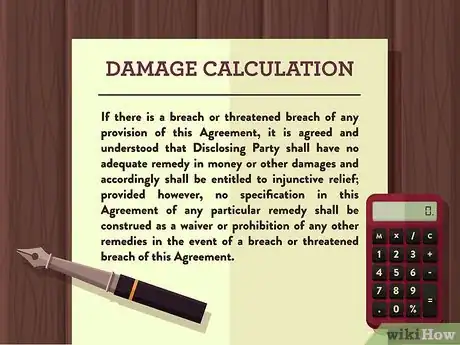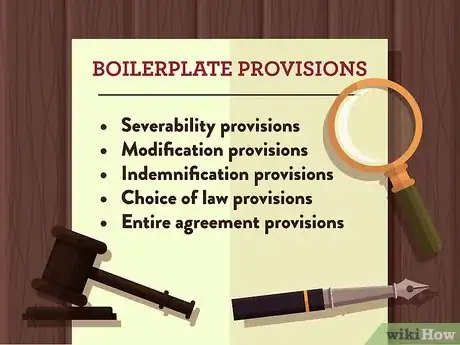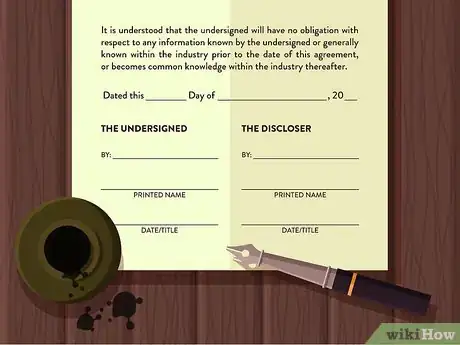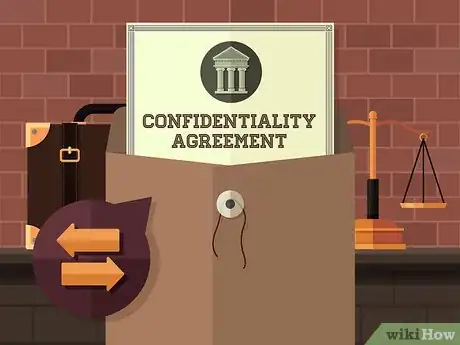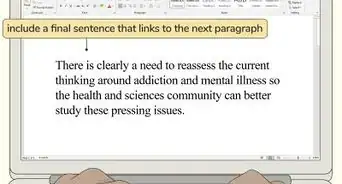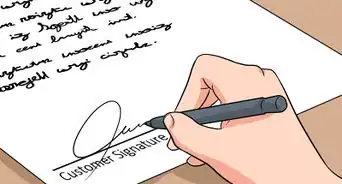This article was co-authored by Clinton M. Sandvick, JD, PhD. Clinton M. Sandvick worked as a civil litigator in California for over 7 years. He received his JD from the University of Wisconsin-Madison in 1998 and his PhD in American History from the University of Oregon in 2013.
There are 7 references cited in this article, which can be found at the bottom of the page.
This article has been viewed 89,734 times.
A confidentiality agreement, also referred to as a non-disclosure agreement, is a contract in which two or more parties agree to keep specific types of conveyed information secret.[1] These agreements can be used to protect any type of information that is not generally known.[2] In order to create an effective confidentiality agreement, you will have to understand your state's contract law, contemplate the contract, write the contract, then execute the contract. Follow the steps in this article and adapt where necessary in order to create the best confidentiality agreement possible.
Steps
Contemplating Your Confidentiality Agreement
-
1Determine whether you have the need for a confidentiality agreement. When you have information that is not generally known to the public, and you plan on sharing that information with someone else, you may want to think about drafting and executing a confidentiality agreement. This type of agreement will help you keep your secret information private and will give you a way to recover damages in case your information gets disseminated. While a confidentiality agreement can be executed in any situation where one party is disseminating private information to another party, some common scenarios in which confidentiality agreements come into play include:
-
2Determine whether you have the ability to enter into a confidentiality agreement. You will need to decide if you have the legal capacity to enter into a valid contract, which involves knowing what you are getting yourself into by entering into the agreement.[5] Also, you will want to know what is needed to create a legally binding contract. Those requirements include:
- An offer;
- Acceptance;
- Valid consideration;
- Mutual assent; and
- A legal purpose.[6]
Advertisement -
3Ensure the terms and provisions you want to put in your contract comply with your state's laws. Contract law is always going to be state law, so you will need to make sure you meet your state's requirements.
- For example, some states have strict laws regarding liquidated damage provisions while other states allow them more freely.[7]
Writing the Confidentiality Agreement
-
1Start with the basic information. This will include the title of your contract and the parties making the agreement. You may also want to include a general introduction that states the purpose of the contract.
- For example, your beginning paragraph may say something like: "This Nondisclosure Agreement (the "Agreement") is entered into by and between _______________ with its principal offices at _______________ ("Disclosing Party") and _______________, located at _______________ ("Receiving Party") for the purpose of preventing the unauthorized disclosure of Confidential Information as defined below. The parties agree to enter into a confidential relationship with respect to the disclosure of certain proprietary and confidential information ("Confidential Information")."[8] As you can see, this opening paragraph defines the parties to the contract and informs the reader of the purpose of the contract.
-
2Define what will be considered confidential information. This section may be one of the most important sections you write. It will define the scope of your agreement and will dictate what information will considered confidential while the agreement is in effect.
- For example, your definition of confidential could look something like this: "The confidential information to be disclosed by Disclosing Party under this Agreement (“Confidential Information”) can be described as and includes: Technical and business information relating to Disclosing Party's proprietary ideas, patentable ideas copyrights and/or trade secrets, existing and/or contemplated products and services, software, schematics, research and development, production, costs, profit and margin information, finances and financial projections, customers, clients, marketing, and current or future business plans and models, regardless of whether such information is designated as “Confidential Information” at the time of its disclosure."[9]
-
3Include any exceptions to what will be considered confidential information. This is another very important section because it will determine what information is going to be specifically excluded from your definition of confidential. The recipient of this information (i.e., the other party to the contract) will have no obligation to keep it private.
- Your exceptions provision may look like this: "Receiving Party's obligations under this Agreement do not extend to information that is: (a) publicly known at the time of disclosure or subsequently becomes publicly known through no fault of the Receiving Party; (b) discovered or created by the Receiving Party before disclosure by Disclosing Party; (c) learned by the Receiving Party through legitimate means other than from the Disclosing Party or Disclosing Party's representatives; or (d) is disclosed by Receiving Party with Disclosing Party's prior written approval."[10]
-
4Assess the allowable uses of the confidential information. Once you have defined what is considered confidential and what is not, you will want to explain how the confidential information you provide to the recipient can be used by that person.
- For example, if you are entering into a confidentiality agreement in order to consider a possible business relationship with another party, your allowable uses provision may look like this: "Recipient shall use the Confidential Information only for the purpose of evaluating potential business and investment relationships with Disclosing Party."[11]
-
5Explain how long the confidentiality agreement will remain in effect. You must be sure to define the length of your confidentiality arrangement when you are writing the agreement. This provision can be structured in a number of ways, but it is most often written to ensure the agreement lasts for a certain number of years.[12]
- For example, if you are writing a provision about the life expectancy of your confidentiality agreement, it may look like this: "This Agreement will remain in effect for a period of five years, starting on the date the agreement is signed and executed by the Disclosing Party and the Recipient."
- However, some confidentiality agreements provide strict provisions stating that the recipient will not be allowed to disclose any confidential information until the disclosing party releases the recipient from the burden of nondisclosure.[13] Such a provision may look something like this: "The nondisclosure provisions of this Agreement shall survive the termination of this Agreement and Receiving Party's duty to hold Confidential Information in confidence shall remain in effect until the Confidential Information no longer qualifies as a trade secret or until Disclosing Party sends Receiving Party written notice releasing Receiving Party from this Agreement, whichever occurs first."[14]
-
6Explain how damages will be calculated. In the event that the recipient of the confidential information disseminates that information wrongfully (i.e., not in accordance with the allowable uses of the confidential information), you will want to have a damages clause in order to define the ramifications of such a breach.
- Most often you will want to include a liquidated damages provision, which states that normal contract damages are not adequate or easily quantifiable and therefore you wish to agree to other damages. Such a provision may look like this: "If there is a breach or threatened breach of any provision of this Agreement, it is agreed and understood that Disclosing Party shall have no adequate remedy in money or other damages and accordingly shall be entitled to injunctive relief; provided however, no specification in this Agreement of any particular remedy shall be construed as a waiver or prohibition of any other remedies in the event of a breach or threatened breach of this Agreement."[15]
-
7Add boilerplate provisions. Towards the end of your contract you will include any standard provisions that are usually found in contracts. Most of these provisions you can simply take from a form contract you find, but make sure you read over them and ensure they say what you want them to. Some of these provisions may include:
- Severability provisions;
- Modification provisions;
- Indemnification provisions;
- Choice of law provisions; and
- Entire agreement provisions.
-
8Leave space for signatures. At the very end of the contract you will make space for all parties to sign the contract. This area should have spaces for your signatures and dates.
Executing the Confidentiality Agreement
-
1Offer your contract to the other party. Once you have written your confidentiality agreement you will offer it to the other party. The other party will then have a number of options:
- The other party may accept the offer in full. In this instance, you will then sign the contract and start performing.
- The other party could reject the offer in full. If this is the case, you will have to write a more acceptable contract to the other party or find someone else to try to contract with.
- The other party might try to negotiate some of the terms of your contract. If this happens, you will negotiate with the other party until you both reach an acceptable agreement.
-
2Negotiate any differences about the terms of your contract. When you negotiate over the terms of your confidentiality agreement, it will most likely be over certain key provisions. Some of the main points of contention are likely to be about:
- What will be considered confidential and what will be excluded from that definition (the discloser will want a broader definition of confidential than will the recipient of that information);
- How the confidential information will be used (the discloser will want a narrower use of the confidential information than will the recipient);
- The manner in which the confidential information is going to be disseminated (whether you want to disseminate it over emails, phone calls, or maybe through the mail); and
- How damages are going to be calculated (the discloser will want stricter and harsher penalties than will the recipient).
-
3Sign your contract and begin performing. When you and the other party are satisfied with the document, you will both sign it and begin performance in the manner you both agreed upon.
Warnings
- You should generally consult an attorney before signing any contract because it is likely to affect your legal rights or obligations.⧼thumbs_response⧽
- Remember that contract law is governed by state law and you should always make sure your contract conforms to all state law requirements.⧼thumbs_response⧽
References
- ↑ http://www.ipwatchdog.com/2008/01/03/what-is-confidentiality-agreement/id=31/
- ↑ http://www.ipwatchdog.com/2008/01/03/what-is-confidentiality-agreement/id=31/
- ↑ http://www.tms.org/pubs/journals/jom/matters/matters-9405.html
- ↑ http://www.carrferrell.com/what-is-a-non-disclosure-agreement
- ↑ http://www.nolo.com/legal-encyclopedia/contracts-basics-33367.html
- ↑ http://www.nolo.com/legal-encyclopedia/contracts-basics-33367.html
- ↑ http://www.nolo.com/legal-encyclopedia/when-are-liquidated-damage-provisions-enforceable.html
- ↑ http://www.nolo.com/legal-encyclopedia/sample-confidentiality-agreement-nda-33343.html
- ↑ http://www.ipwatchdog.com/tradesecret/standard-confidentiality-agreement/
- ↑ http://www.nolo.com/legal-encyclopedia/sample-confidentiality-agreement-nda-33343.html
- ↑ http://www.ipwatchdog.com/tradesecret/standard-confidentiality-agreement/
- ↑ http://www.carrferrell.com/what-is-a-non-disclosure-agreement
- ↑ http://www.nolo.com/legal-encyclopedia/sample-confidentiality-agreement-nda-33343.html
- ↑ http://www.nolo.com/legal-encyclopedia/sample-confidentiality-agreement-nda-33343.html
- ↑ http://www.ipwatchdog.com/tradesecret/standard-confidentiality-agreement/
